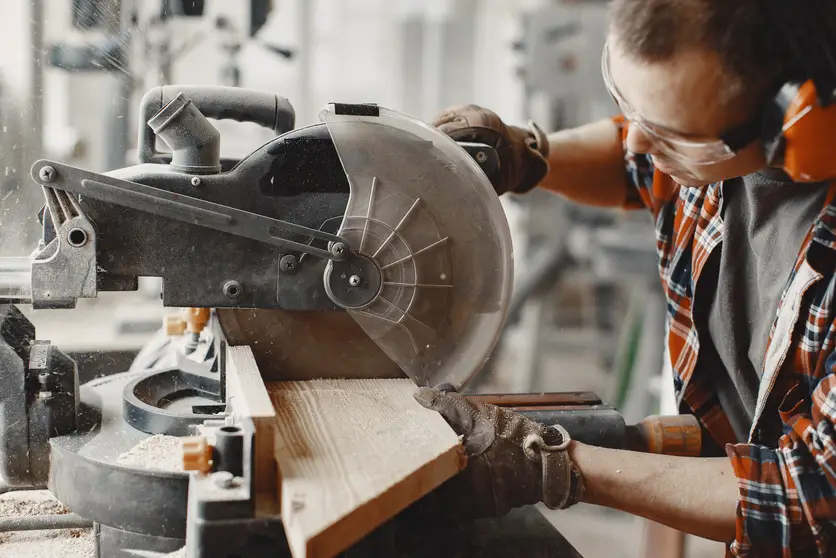Circular saws are a mainstay in most home workshops and for good reason – they’re versatile and powerful tools. But when it comes to cutting wet wood, many people wonder if it’s even possible. In this post, we’ll take a look at how to cut wet wood with a circular saw and offer some tips on how to make the job easier. Stay safe and have fun out there in your workshop!
How to cut wed wood with a circular saw

Cutting wet wood with a circular saw can be tricky, but it is possible if you take the right precautions. First, wet wood is more likely to splinter and kick back, so be sure to wear safety goggles and gloves. Second, the blade of your saw will get clogged more easily when cutting wet wood, so be sure to keep a close eye on it and clean it frequently. Third, your cut will be less accurate when cutting wet wood, so take your time and make sure your measurements are precise. Following these tips will help you cut wet wood safely and successfully with a circular saw.
Is it OK to cut wet wood with a circular saw?
Many DIY enthusiasts enjoy working with wood, and there are a variety of ways to cut it depending on the project. One tool that is commonly used is the circular saw. However, some people may wonder if it is OK to cut wet wood with this type of saw. The answer depends on the type of circular saw being used. If it is a standard circular saw, it is not recommended to cut wet wood as this can damage the blade. However, if it is a specialized wet circular saw, then it should be fine to use on wet wood. In general, it is always best to err on the side of caution and allow the wood to fully dry before attempting to cut it.
What should you not do with a circular saw?
A circular saw is a powerful tool that is commonly used to cut wood. It can be used to cut lumber for home projects, or it can be used by professionals on construction sites. While a circular saw can be a very useful tool, there are certain things that you should not do with it. For example, you should never cut wet wood with a circular saw. The blade of the saw can easily become clogged with water, making it difficult to cut through the wood. Additionally, the blade can become warped from moisture, which can cause the saw to cut unevenly. If you must cut wet wood, it is best to use a hand saw rather than a circular saw.
Why do circular saws kick back?
Circular saws are one of the most commonly used tools in woodworking. They are versatile and can be used for a variety of tasks, from cutting lumber to trimming molding. However, circular saws can also be dangerous, as they are prone to kicking back. This happens when the blade becomes pinched or bound, causing it to spin out of control. The sudden movement can cause the saw to fly back towards the operator, potentially causing serious injuries. There are a few things that you can do to help prevent kickback.
- Make sure that the blade is properly installed and secured.
- Avoid cutting through knots or other hard objects that could cause the blade to bind.
- Keep a firm grip on the saw and be prepared for the kickback if it happens. By following these simple safety measures, you can help reduce the risk of kickback while using a circular saw.
Is it better to cut wood wet or dry?
There are a few things to consider when deciding whether to cut wood wet or dry. One is the type of saw you’re using. A circular saw, for example, can be used on both wet and dry wood, but it’s important to adjust the blade accordingly. Cutting wet wood with a circular saw can cause the blade to clog, resulting in a less than smooth cut. Additionally, cutting wet wood often produces more dust and debris than cutting dry wood, so it’s important to wear proper safety gear if you’re going to be doing any sort of cutting on wet wood. Finally, it’s worth noting that cutting wet wood generally takes more time and effort than cutting dry wood, so if you’re looking to save some time, it’s best to stick with dry lumber.
How deep can a circular saw cut?

Circular saws are one of the most commonly used tools in woodworking, but they can also be one of the most dangerous. Every year, there are thousands of accidents involving circular saws, and many of them result in serious injuries. The depth of the cut is one of the biggest factors in determining how dangerous a circular saw can be. Most circular saws can only cut to a depth of about 2 inches, but some can go as deep as 6 inches. The deeper the cut, the more likely it is that the saw will bind and kick back, potentially causing serious injury. For this reason, it’s important to always use the appropriate blade for the depth of cut you’re trying to make. With a little bit of care and caution, circular saws can be an incredibly useful tool – just be sure to use them safely.
How common are circular saw injuries?
Circular saw injuries are not uncommon. Every year, there are thousands of people who end up in the emergency room because of an accident involving a circular saw. While some of these accidents are due to user error, others are the result of defective products. In either case, it is important to be aware of the dangers of using a circular saw.
Common Factor
One of the most common hazards associated with circular saws is kickback. This occurs when the blade catches on something and is suddenly ejected from the saw. If the blade hits someone, it can cause serious injury. Kickback is most likely to occur when the saw is used improperly, such as when trying to cut through a piece of metal that is too thick. Another hazard is contact with the spinning blade. If the hand or fingers come into contact with the blade, they can be severely cut or even amputated. For this reason, it is important to always use proper safety gear when operating a circular saw.
Conclusion
So, can you cut wet wood with a circular saw? The answer is yes – but there are a few things you need to keep in mind. For one, make sure the blade on your saw is sharp; if it’s not, the saw will bog down and you’ll end up with an uneven cut. You’ll also want to use a slower cutting speed when working with wet wood, and take care to avoid binding the blade by keeping the stock flat against the fence and table. With these tips in mind, go ahead and give it a try!

I’m John Carry, also known as a woodworker I have been a professional saw expert for over 10 years. I’d work with every type of saw machine out there, and experiment to find which tools work better.
I’m always looking for ways to improve my skills and help those around me. I love my job and am always happy to share my knowledge with others.

